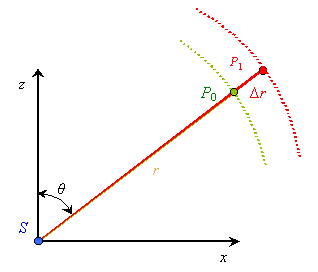V.4 No 1 |
5 |
| On gradient of potential function | |
|
|
V.4 No 1 |
5 |
| On gradient of potential function | |
|
|
In this view we can consider the model of field of pulsing source as a system of equipotential lines with decreasing amplitude of potential with the distance from source which propagate from the source with velocity c. With it the equipotential line radiated by the source at some moment t0 will reach the studied point P0 located at the distance r from the source during the time |
|
(8) |
(see Fig. 3), and point P1
located at the distance |
|
|
(9) |
 |
Fig. 3. Equipotential lines of pulsing point source |
| So, if we now want to determine the derivative of scalar
potential along the direction from the field source, we will see that at the points P0
and P1 there are the potentials radiated by the source with the time
interval |
|
|
(10) |
As we can see from (10), the dynamic gradient (which we wrote down with the capital letter, in order to distinguish it from the gradient of function with respect to coordinates) consists of two summands. The first summand is a known gradient for stationary fields, and the second summand accounts the time variation of gradient of potential due to dynamic pattern of the field. But this second summand is just the time-dependent summand
in (1). And we can mark the feature of limit passing from the increment of function to the
time derivative in second summand. Despite in second equality of derivation (10) we take
the difference of potentials radiated at the moment (t - |
|